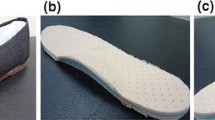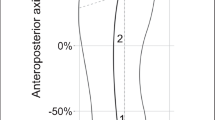Abstract
Osteoarthritis (OA) of the knee is associated with alterations in gait. As an alternative to force plates, instrumented force shoes (IFSs) can be used to measure ground reaction forces. This study evaluated the influence of IFS on gait pattern in patients with knee OA. Twenty patients with knee OA walked in a gait laboratory on IFS and control shoes (CSs). An optoelectronic system and force plate were used to perform 3D gait analyses. A comparison of temporal-spatial gait parameters, kinematics, and kinetics was made between IFS and CS. Patients wearing IFS showed a decrease in walking velocity and cadence (8%), unchanged stride length, an increase in stance time (13%), stride time (11%) and step width (14%). No differences were found in knee adduction moment or knee kinematics. Small differences were found in foot and ankle kinematics (2–5°), knee transverse moments (5%), ankle frontal (3%) and sagittal moments (1%) and ground reaction force (1–6%). The gait of patients with knee OA was only mildly influenced by the IFS, due to increased shoe height and weight and a change in sole stiffness. The changes were small compared to normal variation and clinically relevant differences. Importantly, in OA patients no effect was found on the knee adduction moment.


Similar content being viewed by others
Abbreviations
- OA:
-
Osteoarthritis
- IFS:
-
Instrumented force shoe
- KAdM:
-
Knee adduction moment
- GRF:
-
Ground reaction force
- CoP:
-
Centre of pressure
- CS:
-
Control shoe
- IMMS:
-
Inertial and magnetic measurement system
- RMSE:
-
Root mean square error
- SD:
-
Standard deviation
- BW:
-
Body weight
- H:
-
Body height
References
Altman RD, Gold GE (2007) Atlas of individual radiographic features in osteoarthritis, revised. Osteoarthritis Cartilage 15(Suppl A):A1–A56
Altman R, Asch E, Bloch D, Bole G, Borenstein D, Brandt K, Christy W, Cooke TD, Greenwald R, Hochberg M (1986) Development of criteria for the classification and reporting of osteoarthritis Classification of osteoarthritis of the knee. Diagnostic and Therapeutic Criteria Committee of the American Rheumatism Association. Arthritis Rheum 29:1039–1049
Andriacchi TP, Mundermann A, Smith RL, Alexander EJ, Dyrby CO, Koo S (2004) A framework for the in vivo pathomechanics of osteoarthritis at the knee. Ann Biomed Eng 32:447–457
Astephen JL, Deluzio KJ, Caldwell GE, Dunbar MJ (2008) Biomechanical changes at the hip, knee, and ankle joints during gait are associated with knee osteoarthritis severity. J Orthop Res 26:332–341
Baliunas AJ, Hurwitz DE, Ryals AB, Karrar A, Case JP, Block JA, Andriacchi TP (2002) Increased knee joint loads during walking are present in subjects with knee osteoarthritis. Osteoarthritis Cartilage 10:573–579
Borjesson M, Weidenhielm L, Elfving B, Olsson E (2007) Tests of walking ability at different speeds in patients with knee osteoarthritis. Physiother Res Int 12:115–121
Callisaya ML, Blizzard L, Schmidt MD, McGinley JL, Srikanth VK (2010) Ageing and gait variability—a population-based study of older people. Age Ageing 39:191–197
Cappozzo A, Catani F, Croce UD, Leardini A (1995) Position and orientation in space of bones during movement: anatomical frame definition and determination. Clin Biomech (Bristol, Avon) 10:171–178
Chen CPC, Chen MJL, Pei YC, Lew HL, Wong PY, Tang SFT (2003) Sagittal plane loading response during gait in different age groups and in people with knee osteoarthritis. Am J Phys Med Rehabil 82:307–312
Cutti AG, Ferrari A, Garofalo P, Raggi M, Cappello A, Ferrari A (2010) ‘Outwalk’: a protocol for clinical gait analysis based on inertial and magnetic sensors. Med Biol Eng Comput 48:17–25
Eisenhardt JR, Cook F, Pregler I, Foehl HC (1996) Changes in temporal gait characteristics and pressure distribution for bare feet versus various heel heights. Gait Posture 4:280–286
Foroughi N, Smith R, Vanwanseele B (2009) The association of external knee adduction moment with biomechanical variables in osteoarthritis: a systematic review. Knee 16:303–309
Fransen M, Crosbie J, Edmonds J (1997) Reliability of gait measurements in people with osteoarthritis of the knee. Phys Ther 77:944–953
Greene BR, McGrath D, O’Neill R, O’Donovan KJ, Burns A, Caulfield B (2010) An adaptive gyroscope-based algorithm for temporal gait analysis. Med Biol Eng Comput 48:1251–1260
Hinman RS, Bennell KL (2009) Advances in insoles and shoes for knee osteoarthritis. Curr Opin Rheumatol 21:164–170
Hof AL, Elzinga H, Grimmius W, Halbertsma JPK (2002) Speed dependence of averaged EMG profiles in walking. Gait Posture 16:78–86
Hunt MA, Birmingham TB, Giffin JR, Jenkyn TR (2006) Associations among knee adduction moment, frontal plane ground reaction force, and lever arm during walking in patients with knee osteoarthritis. J Biomech 39:2213–2220
Kaufman KR, Hughes C, Morrey BF, Morrey M, An KN (2001) Gait characteristics of patients with knee osteoarthritis. J Biomech 34:907–915
Kellgren JH, Lawrence JS (1957) Radiological assessment of osteo-arthrosis. Ann Rheum Dis 16:494–502
Kemp G, Crossley KM, Wrigley TV, Metcalf BR, Hinman RS (2008) Reducing joint loading in medial knee osteoarthritis: shoes and canes. Arthritis Rheum 59:609–614
Liedtke C, Fokkenrood SA, Menger JT, van der Kooij H, Veltink PH (2007) Evaluation of instrumented shoes for ambulatory assessment of ground reaction forces. Gait Posture 26:39–47
Luinge HJ, Veltink PH (2005) Measuring orientation of human body segments using miniature gyroscopes and accelerometers. Med Biol Eng Comput 43:273–282
Menant JC, Perry SD, Steele JR, Menz HB, Munro BJ, Lord SR (2008) Effects of shoe characteristics on dynamic stability when walking on even and uneven surfaces in young and older people. Arch Phys Med Rehabil 89:1970–1976
Menant JC, Steele JR, Menz HB, Munro BJ, Lord SR (2008) Optimizing footwear for older people at risk of falls. J Rehabil Res Dev 45:1167–1181
Menant JC, Steele JR, Menz HB, Munro BJ, Lord SR (2009) Effects of walking surfaces and footwear on temporo-spatial gait parameters in young and older people. Gait Posture 29:392–397
Miyazaki T, Wada M, Kawahara H, Sato M, Baba H, Shimada S (2002) Dynamic load at baseline can predict radiographic disease progression in medial compartment knee osteoarthritis. Ann Rheum Dis 61:617–622
Moisio KC, Sumner DR, Shott S, Hurwitz DE (2003) Normalization of joint moments during gait: a comparison of two techniques. J Biomech 36:599–603
Mundermann A, Dyrby CO, Andriacchi TP (2005) Secondary gait changes in patients with medial compartment knee osteoarthritis: increased load at the ankle, knee, and hip during walking. Arthritis Rheum 52:2835–2844
Nester CJ, Liu AM, Ward E, Howard D, Cocheba J, Derrick T (2010) Error in the description of foot kinematics due to violation of rigid body assumptions. J Biomech 43:666–672
O’Connor CM, Thorpe SK, O’Malley MJ, Vaughan CL (2007) Automatic detection of gait events using kinematic data. Gait Posture 25:469–474
O’Donovan KJ, Kamnik R, O’Keeffe DT, Lyons GM (2007) An inertial and magnetic sensor based technique for joint angle measurement. J Biomech 40:2604–2611
Roetenberg D, Baten CT, Veltink PH (2007) Estimating body segment orientation by applying inertial and magnetic sensing near ferromagnetic materials. IEEE Trans Neural Syst Rehabil Eng 15:469–471
Rouhani H, Favre J, Crevoisier X, Aminian K (2010) Ambulatory assessment of 3D ground reaction force using plantar pressure distribution. Gait Posture 32:311–316
Rutherford DJ, Hubley-Kozey CL, Deluzio KJ, Stanish WD, Dunbar M (2008) Foot progression angle and the knee adduction moment: a cross-sectional investigation in knee osteoarthritis. Osteoarthritis Cartilage 16:883–889
Schache AG, Baker R (2007) On the expression of joint moments during gait. Gait Posture 25:440–452
Schepers HM, Koopman HF, Veltink PH (2007) Ambulatory assessment of ankle and foot dynamics. IEEE Trans Biomed Eng 54:895–902
Schepers HM, van Asseldonk EH, Buurke JH, Veltink PH (2009) Ambulatory estimation of center of mass displacement during walking. IEEE Trans Biomed Eng 56:1189–1195
Schwartz MH, Trost JP, Wervey RA (2004) Measurement and management of errors in quantitative gait data. Gait Posture 20:196–203
Selles RW, Bussmann JB, Klip LM, Speet B, Van Soest AJ, Stam HJ (2004) Adaptations to mass perturbations in transtibial amputees: kinetic or kinematic invariance? Arch Phys Med Rehabil 85:2046–2052
Shakoor N, Lidtke RH, Sengupta M, Fogg LF, Block JA (2008) Effects of specialized footwear on joint loads in osteoarthritis of the knee. Arthritis Rheum 59:1214–1220
Sharma L, Hurwitz DE, Thonar EJ, Sum JA, Lenz ME, Dunlop DD, Schnitzer TJ, Kirwan-Mellis G, Andriacchi TP (1998) Knee adduction moment, serum hyaluronan level, and disease severity in medial tibiofemoral osteoarthritis. Arthritis Rheum 41:1233–1240
Stansfield BW, Hillman SJ, Hazlewood ME, Lawson AA, Mann AM, Loudon IR, Robb JE (2001) Sagittal joint kinematics, moments, and powers are predominantly characterized by speed of progression, not age, in normal children. J Pediatr Orthop 21:403–411
Thorp LE, Sumner DR, Block JA, Moisio KC, Shott S, Wimmer MA (2006) Knee joint loading differs in individuals with mild compared with moderate medial knee osteoarthritis. Arthritis Rheum 54:3842–3849
van den Noort JC, Scholtes VA, Harlaar J (2009) Evaluation of clinical spasticity assessment in cerebral palsy using inertial sensors. Gait Posture 30:138–143
van der Esch M, Steultjens M, Harlaar J, Wolterbeek N, Knol D, Dekker J (2008) Varus-valgus motion and functional ability in patients with knee osteoarthritis. Ann Rheum Dis 67:471–477
Veltink PH, Liedtke C, Droog E, van der Kooij H (2005) Ambulatory measurement of ground reaction forces. IEEE Trans Neural Syst Rehabil Eng 13:423–427
Vincent WJ (2005) Correlation, bivariate regression and multiple regression. In: Robertson LD, Ewing AS, Rivera MM (eds) Statistics in kinesiology. Human Kinetics, Champaign, pp 93–122
Wu G, Cavanagh PR (1995) ISB recommendations for standardization in the reporting of kinematic data. J Biomech 28:1257–1261
Zatsiorsky VM (2002) Kinetics of human motion. Human Kinetics, Champaign
Zhou H, Hu H, Harris N (2005) Application of wearable inertial sensors in stroke rehabilitation. Conf Proc IEEE Eng Med Biol Soc 7:6825–6828
Acknowledgement
This study is part of the FreeMotion project (www.freemotion.tk) funded by the Dutch Ministry of Economic Affairs and Senter Novem. The authors want to thank Tanneke Vogelaar and Kim van Hutten for assistance during the measurements, and the patients for their participation in the study. Part of this study has been presented at the European Society of Movement Analysis for Adults and Children (ESMAC) Annual meeting 2009, London, 17–19 September 2009. We certify that no party having a direct interest in the results of the research supporting this article has or will confer a benefit on us or on any organization with which we are associated.
Author information
Authors and Affiliations
Corresponding author
Rights and permissions
About this article
Cite this article
van den Noort, J., van der Esch, M., Steultjens, M.P. et al. Influence of the instrumented force shoe on gait pattern in patients with osteoarthritis of the knee. Med Biol Eng Comput 49, 1381–1392 (2011). https://doi.org/10.1007/s11517-011-0818-z
Received:
Accepted:
Published:
Issue Date:
DOI: https://doi.org/10.1007/s11517-011-0818-z




